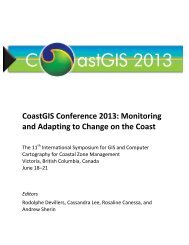in Context the SCotian Shelf - COINAtlantic
in Context the SCotian Shelf - COINAtlantic
in Context the SCotian Shelf - COINAtlantic
Create successful ePaper yourself
Turn your PDF publications into a flip-book with our unique Google optimized e-Paper software.
Figure 2: Detailed surface circulation on <strong>the</strong> Scotian <strong>Shelf</strong>. (Source: adapted from C.Hannah <strong>in</strong> Breeze et al 2002).<br />
be attributed to two ma<strong>in</strong> causes: a change <strong>in</strong> <strong>the</strong><br />
volume of water <strong>in</strong> <strong>the</strong> ocean and changes caused<br />
by <strong>the</strong> s<strong>in</strong>k<strong>in</strong>g or ris<strong>in</strong>g of land. Changes <strong>in</strong> <strong>the</strong><br />
volume of water may be due to ris<strong>in</strong>g or lower<strong>in</strong>g<br />
of temperatures, lead<strong>in</strong>g to <strong>the</strong> <strong>the</strong>rmal expansion<br />
or contraction of water, as well as changes <strong>in</strong> <strong>the</strong><br />
amount of water stored <strong>in</strong> polar ice and on land<br />
<strong>in</strong> glaciers, lakes, rivers, and o<strong>the</strong>r reservoirs. In<br />
Atlantic Canada, <strong>the</strong> land is still ris<strong>in</strong>g and s<strong>in</strong>k<strong>in</strong>g <strong>in</strong><br />
response to <strong>the</strong> retreat of <strong>the</strong> last glacier more than<br />
10 000 years ago. This ris<strong>in</strong>g and s<strong>in</strong>k<strong>in</strong>g, known as<br />
post-glacial or isostatic rebound, is caus<strong>in</strong>g a large<br />
area, <strong>in</strong>clud<strong>in</strong>g Nova Scotia, to s<strong>in</strong>k and thus sea<br />
levels to rise. Overall, <strong>the</strong>re is a general trend of sea<br />
level rise on <strong>the</strong> Atlantic coast of Nova Scotia. Petrie<br />
et al. (2009) estimated a total value of 31.9 cm/<br />
century at Halifax, with 23 cm/century attributable<br />
to post-glacial rebound (Tush<strong>in</strong>gham and Peltier<br />
1991 cited <strong>in</strong> Petrie et al. 2009).<br />
2.4 OCEANOGRAPHIC<br />
Conditions<br />
The Scotian <strong>Shelf</strong> is most strongly <strong>in</strong>fluenced by three<br />
currents: <strong>the</strong> Nova Scotia Current, <strong>the</strong> Labrador Current<br />
and <strong>the</strong> Gulf Stream. Relatively cool, fresh waters<br />
flow from <strong>the</strong> Gulf of St. Lawrence through <strong>the</strong> Cabot<br />
Strait. Part of this flow turns at Cape Breton to flow<br />
southwestward along Nova Scotia’s Atlantic coast,<br />
while <strong>the</strong> rest of <strong>the</strong> flow cont<strong>in</strong>ues through <strong>the</strong> Laurentian<br />
Channel to <strong>the</strong> shelf break. There, it turns and<br />
jo<strong>in</strong>s with <strong>the</strong> Labrador Current to flow southwestwards<br />
along <strong>the</strong> shelf edge. The third major current,<br />
<strong>the</strong> Gulf Stream, flows nor<strong>the</strong>astwards. Its warmer,<br />
saltier waters mix with <strong>the</strong> cool Labrador Current<br />
waters over <strong>the</strong> Scotian Slope, form<strong>in</strong>g a water mass<br />
known as slope water. The slope water periodically<br />
http://co<strong>in</strong>atlantic.ca/<strong>in</strong>dex.php/state-of-<strong>the</strong>-scotian-shelf<br />
13













